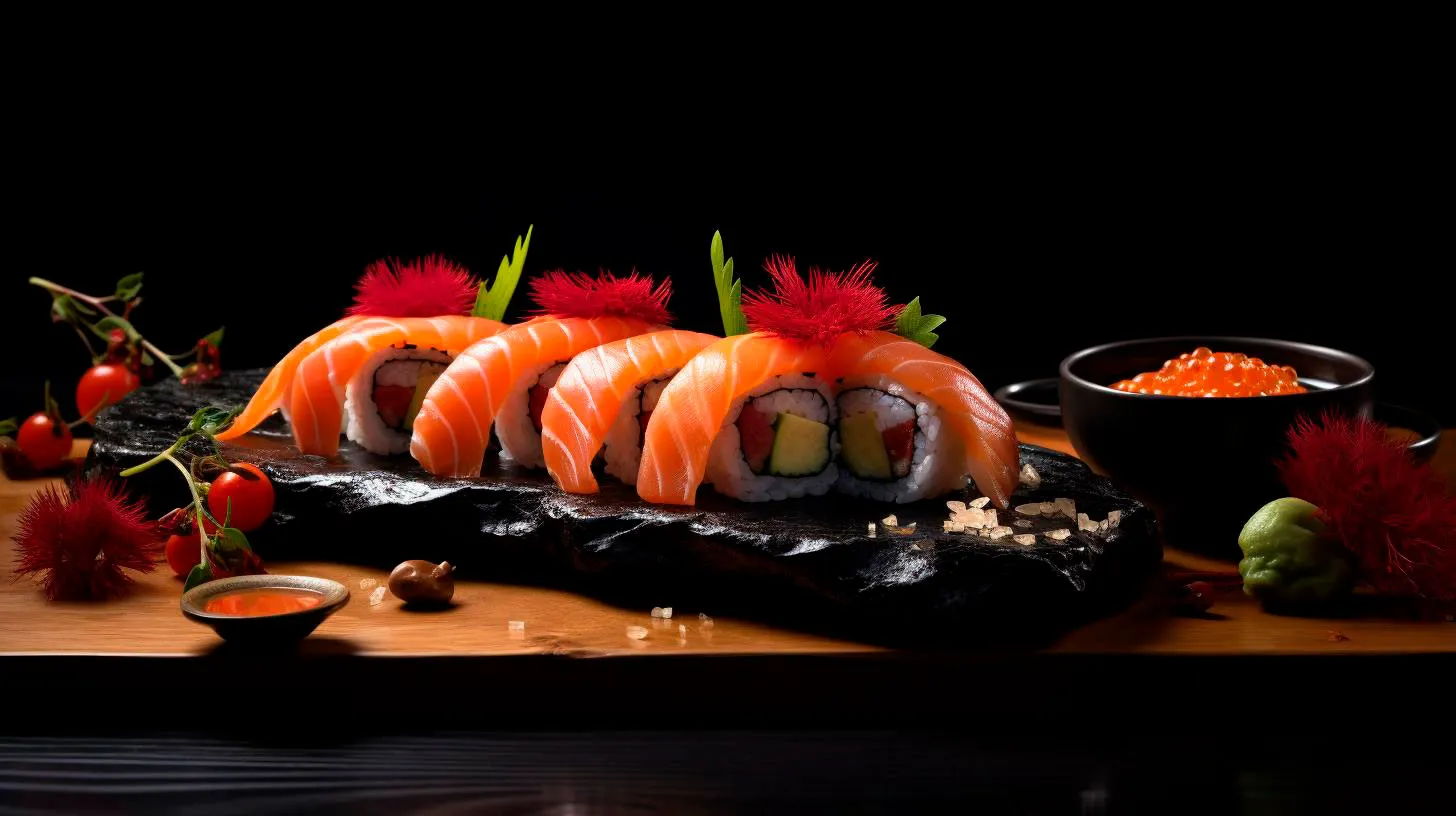Uncovering Sushi Etiquette Do’s and Don’ts When Dining Out
This article will guide you through the do’s and don’ts of sushi etiquette, ensuring you have a delightful and enjoyable dining experience.
The Do’s of Sushi Etiquette
1. Use chopsticks or your hands: When eating sushi, it is customary to use chopsticks. However, if you are not comfortable using them, it is acceptable to eat sushi with your hands. Whichever method you choose, make sure to handle your food with care and avoid touching other items on the table.
2. Dip sushi lightly: When eating sushi rolls or nigiri, lightly dip the fish, not the rice, into the soy sauce. Excessive dipping can overpower the delicate flavors and also lead to the sushi falling apart. Additionally, try to avoid adding wasabi and soy sauce directly to your sushi; instead, consult with the chef for their recommendation.
3. Eat sushi in one bite: To fully appreciate the flavors and textures of sushi, it is best to eat each piece in one bite. This allows you to experience the different components harmoniously. If the sushi piece is too large, you can politely ask the chef to make a smaller bite-size piece for you.
4. Show appreciation to the chef: Sushi chefs put great skill and effort into preparing each dish. It is a sign of respect to show your appreciation by saying “arigatou gozaimasu” (thank you) after each piece of sushi or at the end of your meal. This small gesture goes a long way in building a good rapport with the chef.
5. Practice good chopstick etiquette: When using chopsticks, avoid pointing them at others or leaving them sticking upright in your bowl. It is considered impolite and reminiscent of funeral rituals in Japanese culture. Instead, place the chopsticks on the chopstick rest or lay them horizontally across your plate when not in use.
The Don’ts of Sushi Etiquette
1. Don’t mix wasabi into soy sauce: Mixing wasabi into your soy sauce may seem tempting, but it is not traditional sushi etiquette. The sushi chef has already carefully balanced the flavors, and adding extra wasabi can overpower the dish. Instead, apply a small amount of wasabi directly to the sushi if desired.
2. Don’t rub chopsticks together: In some cultures, it is a common practice to rub chopsticks together to remove splinters or smooth the edges. However, in Japanese culture, this action is considered rude and implies that you doubt the quality of the chopsticks provided.
3. Don’t use too much soy sauce: While dipping sushi in soy sauce is customary, avoid using excessive amounts. It not only masks the delicate flavors but can also be seen as wasteful. A little dip is enough to enhance the taste without overpowering it.
4. Don’t consume ginger with sushi: Many people mistakenly eat ginger with their sushi. However, the pickled ginger is intended as a palate cleanser between different types of sushi. Take a small piece of ginger between bites to refresh your taste buds.
5. Don’t be afraid to ask questions: If you are unfamiliar with certain sushi terminology, types of fish, or preparation techniques, don’t hesitate to ask the sushi chef. They are highly knowledgeable and passionate about their craft and will be happy to assist you in making informed choices.
Key Takeaways
- Use chopsticks or your hands when eating sushi.
- Dip sushi lightly and avoid excessive soy sauce.
- Eat sushi in one bite for the best dining experience.
- Show appreciation to the sushi chef for their skill and effort.
- Practice good chopstick etiquette and avoid rubbing them together.
- Avoid mixing wasabi into soy sauce and using too much soy sauce.
- Do not consume ginger with sushi; it is meant as a palate cleanser.
- Feel free to ask questions and seek guidance from the sushi chef.
By following these do’s and don’ts of sushi etiquette, you will not only enhance your dining experience but also demonstrate respect for the Japanese culture and the art of sushi making. Delight in the flavors, textures, and presentation of each piece of sushi, knowing that you are enjoying it the right way.
Scientific Insights for an Informed Dining Experience: Health Benefits of Sushi
The Nutritional Powerhouse
Sushi is primarily made from raw fish, rice, and various vegetables. Each of these ingredients brings its own nutritional benefits to the table:
- Raw Fish: Fish used in sushi, such as salmon, tuna, and mackerel, are rich in omega-3 fatty acids, which are essential for brain development and maintaining heart health. These fatty acids also have anti-inflammatory properties that can reduce the risk of chronic diseases.
- Rice: Sushi is typically made with short-grain white rice, which is a good source of carbohydrates. It provides energy, aids in digestion, and contains small amounts of essential minerals like iron and zinc.
- Vegetables: Sushi often incorporates various vegetables like cucumber, avocado, and seaweed. These veggies offer an array of vitamins, minerals, and dietary fiber, contributing to a well-balanced meal.
By combining these ingredients, sushi becomes a nutritional powerhouse packed with essential nutrients that can support overall health and well-being.
Key Health Benefits
Incorporating sushi into your diet can provide several health benefits:
1. Heart Health
The omega-3 fatty acids found abundantly in fish used in sushi have been associated with a reduced risk of heart disease. These fats help lower blood pressure, reduce triglyceride levels, and improve heart rhythm, thereby promoting cardiovascular health.
2. Weight Management
Sushi, when consumed in moderation, can be an excellent choice for weight management. It is low in calories and fat, making it a satisfying yet healthy option. Additionally, the high protein content in fish helps increase satiety and boosts metabolism.
3. Brain Function
Omega-3 fatty acids found in fish are crucial for brain development and function. Regular consumption of sushi can aid in enhancing cognitive abilities and reducing the risk of age-related mental decline.
4. Antioxidant Boost
The various vegetables used in sushi contain antioxidants that help neutralize harmful free radicals in the body. These antioxidants can reduce the risk of chronic diseases and support overall cellular health.
5. Improved Digestion
Sushi, with its combination of rice and fiber-rich vegetables, can promote healthy digestion. The fiber aids in regulating bowel movements and prevents constipation, while the probiotics found in fermented sushi options like kimchi can improve gut health.
The Key Takeaways
Next time you savor a plate of sushi, remember these key takeaways:
- Sushi is a nutritional powerhouse, offering a blend of essential nutrients from fish, rice, and vegetables.
- The omega-3 fatty acids in fish promote heart health, brain function, and can reduce the risk of chronic diseases.
- Sushi is a weight-friendly option due to its low calorie and fat content along with the metabolism-boosting properties of fish protein.
- Antioxidants present in sushi’s vegetables contribute to overall health and well-being by neutralizing harmful free radicals.
- Incorporating sushi into your diet can support digestion, thanks to the fiber content and gut-friendly probiotics.
So, the next time you’re looking for a tasty and healthful dining option, sushi can be your go-to choice. Its scientific benefits and nutritional profile make it an excellent addition to a well-balanced diet. Enjoy the amazing flavors of sushi while reaping its vast range of health advantages!
Navigating Sushi Menus: Decoding Traditional and Modern Options
In this article, we will break down the traditional and modern sushi options, helping you decipher a sushi menu and make informed choices.
Traditional Sushi
Traditional sushi encompasses the classic and time-honored styles that have been enjoyed for generations. Here are some key traditional sushi options you may encounter:
- Nigiri: Nigiri sushi consists of bite-sized portions of fresh fish or seafood placed on a small hand-formed mound of seasoned rice. It is often garnished with a touch of wasabi or a thin strip of nori (seaweed). Nigiri sushi allows you to fully appreciate the freshness and texture of the fish.
- Sashimi: Sashimi is another traditional sushi style that excludes rice altogether. It features thinly sliced raw fish or seafood served with soy sauce and wasabi. The purity of the fish’s flavor and texture shines through in this popular choice.
- Maki: Maki sushi refers to the familiar sushi rolls we often see. These rolls consist of ingredients like fish, seafood, vegetables, and rice, all wrapped in a sheet of nori. Maki sushi offers a perfect combination of flavors and textures in each bite.
By understanding these traditional sushi options, you can confidently make choices that align with your preferences.
Modern Sushi Innovations
In recent years, sushi has evolved into a diverse culinary art form, as chefs experiment with exciting flavor combinations and presentation. Here are some modern sushi innovations commonly found on menus:
- Tempura Rolls: Combining the popular Japanese dish tempura with sushi, these rolls feature lightly battered and fried ingredients, giving a delightful crunch and texture to each bite.
- Spicy Tuna and Salmon Rolls: These rolls are an example of how sushi chefs have incorporated spicy flavors into their creations. The combination of spicy mayo, tuna or salmon, and fresh vegetables creates a tantalizing taste experience.
- Fusion Sushi: Fusion sushi combines traditional Japanese ingredients with flavors from other culinary traditions, resulting in unique creations like sushi tacos or sushi burritos. This fusion of flavors can open up a whole new world of culinary exploration for sushi lovers.
The modern sushi options provide a refreshing twist on traditional sushi, appealing to a broader range of tastes and preferences.
Key Takeaways
Navigating a sushi menu doesn’t have to be a daunting task. By understanding the traditional and modern options available, you can confidently explore and enjoy this incredible cuisine. Here are some key takeaways to remember:
- Traditional sushi consists of nigiri, sashimi, and maki rolls.
- Modern sushi introduces innovative creations like tempura rolls, spicy tuna and salmon rolls, and fusion sushi.
- Understanding the menu terminology and knowing your preferences will empower you to order sushi with confidence.
Sushi is not only a delicious meal but also a cultural experience. Exploring and deciphering the vast array of sushi options will allow you to fully appreciate the art and craftsmanship that goes into each bite. So, next time you find yourself perusing a sushi menu, use this guide to navigate your way through, and prepare to indulge in a culinary adventure!
Exploring Sushi Pairings: Optimal Combinations for Ultimate Flavor
In this article, we will delve into the world of sushi pairings and uncover the optimal combinations that create the ultimate flavor sensation.
The Importance of Sushi Pairings
Pairing sushi with the right flavors enhances the overall taste and elevates the dining experience. Just like wine pairing, understanding the flavors in sushi and how they interact with other ingredients can truly transform your meal. From the subtle nuances of fresh fish to the tanginess of pickled vegetables, each element in sushi demands careful consideration when it comes to pairing.
By choosing the right ingredients to accompany your sushi, you can balance flavors, add contrasting textures, and create a harmonious taste profile that will surprise and delight your taste buds. So, let’s explore some popular sushi pairings that are well-known for their optimal combinations.
Popular Sushi Pairings
1. Soy Sauce and Wasabi
No sushi experience is complete without soy sauce and wasabi. Soy sauce provides a salty, umami flavor that brings out the taste of the fish, while wasabi adds a spicy kick to enhance the overall flavor profile. However, it is important to use these condiments in moderation to avoid overpowering the delicate flavors of the sushi.
2. Sake and Fatty Fish
Sake, the traditional Japanese rice wine, is a popular choice for pairing with sushi. Its subtle sweetness and smooth texture complement the fatty richness of fish like salmon, mackerel, and tuna. The complex flavors of sake elevate the flavors of the fish, creating a memorable combination that is both refreshing and indulgent.
3. Pickled Ginger and Fatty Tuna
Known as “gari,” pickled ginger acts as a palate cleanser between bites of sushi, helping to refresh the taste buds and enhance the flavors of different types of fish. When paired with fatty tuna, the slight acidity of pickled ginger cuts through the richness of the fish, providing a delightful contrast that brings out the best of both flavors.
4. Green Tea and White Fish
Green tea is a versatile beverage that pairs well with various types of sushi. Its earthy and slightly bitter notes complement the delicate flavors of white fish, such as halibut and flounder. The refreshing taste of green tea cleanses the palate and prepares it for the next delightful bite.
Key Takeaways
- Pairing sushi with the right flavors enhances the overall taste and elevates the dining experience.
- Choosing the right ingredients to accompany sushi can balance flavors, add contrasting textures, and create a harmonious taste profile.
- Soy sauce and wasabi provide a salty, umami flavor, while sake complements fatty fish.
- Pickled ginger acts as a palate cleanser and enhances the flavors of different types of fish.
- Green tea is a versatile beverage that pairs well with various types of sushi.
In conclusion, exploring the world of sushi pairings can add a new level of enjoyment and depth to your dining experience. Understanding the flavors and how they interact with different ingredients allows you to create optimal combinations that bring out the best in each bite. So, the next time you savor sushi, don’t forget to consider the ideal pairings to unlock the ultimate flavor sensation.



